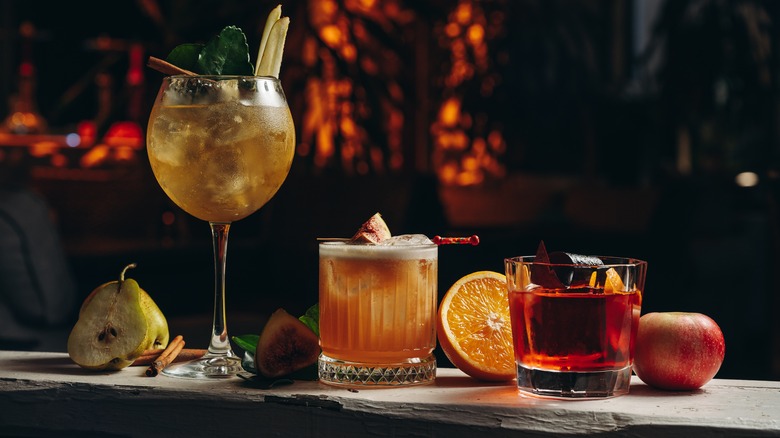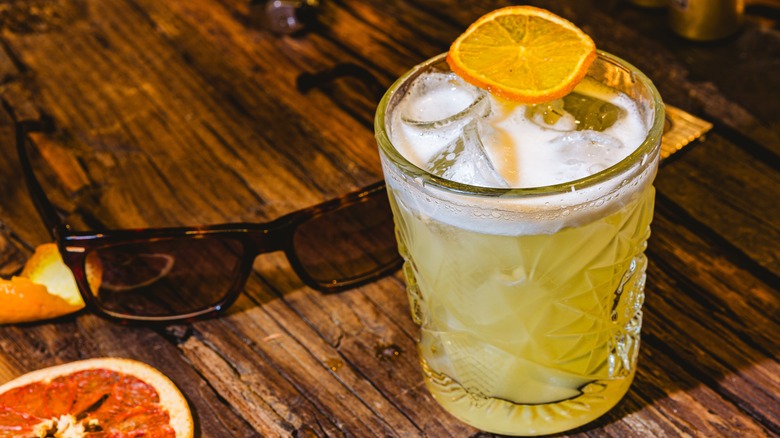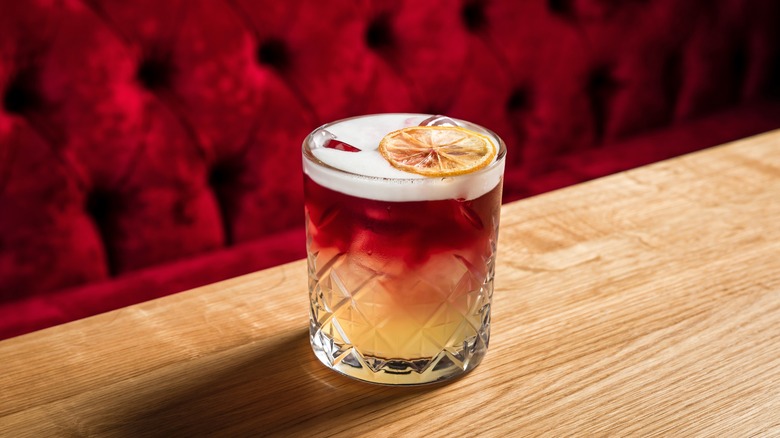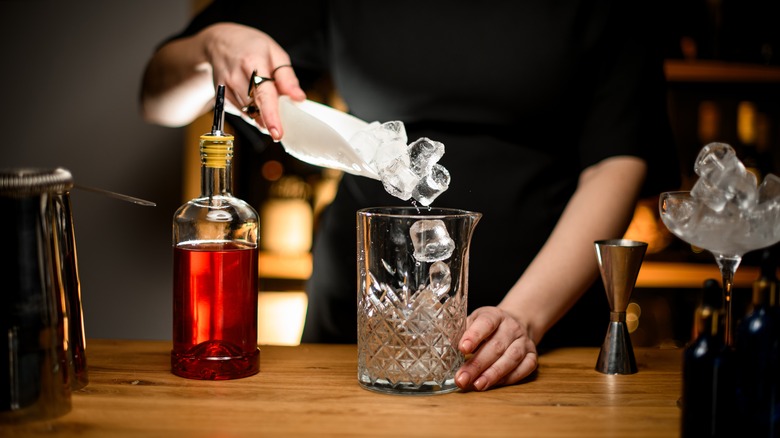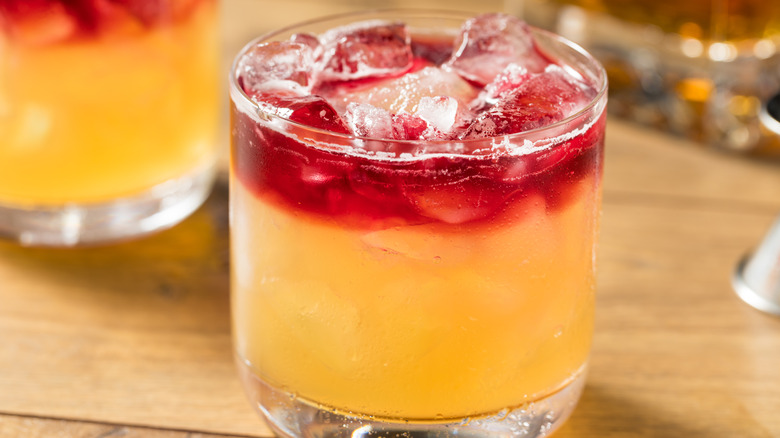What Separates A New York Sour From A Whiskey Sour?
Ah, whiskey — a spirit as versatile as it is beloved. Whether you're sipping it neat or chasing it with a shot of pickle brine, it's a crowd-pleaser that's both classic and cool. But when it comes to cocktails, the whiskey sour category is where things get interesting.
Even if you're already a fan of the whiskey sour, you might not have heard of its chic cousin, the New York sour. While they're both built on the same base of whiskey, lemon juice, and a touch of sweetness, the New York sour takes it one step further with a top layer of red wine that brings bold, fruity depth to the drink. So, what's the real difference between these two cocktails? Is the New York sour just a dressed-up whiskey sour, or does it stand on its own? Let's dive into what sets these cocktails apart in terms of taste, presentation, and style.
What is a whiskey sour?
The whiskey sour is an iconic cocktail, holding its place as one of the oldest and most beloved drinks for whiskey lovers. It was first recorded in 1862 in "Jerry Thomas' Bartenders Guide," one of the earliest known bartending manuals.
The traditional whiskey sour typically includes bourbon or rye, freshly squeezed lemon juice, and simple syrup. The whiskey's robust character is perfectly offset by the sweetness of the syrup and the citrus' unique, tangy acidity — this is why you can't skip the lemon juice in a whiskey sour. Some recipes add a dash of egg white, which is shaken to create a foamy, velvety texture that sits atop the drink. This isn't essential, but it's one of those worthwhile extra steps when making a whiskey sour, lending a creamy mouthfeel and elegant look. Whether or not it includes egg white, the whiskey sour is a classic drink for any whiskey lover who enjoys a smooth, reliable cocktail with a mix of sweet and tart flavors that's sure to leave a pleasant burn in your belly.
What is a New York sour?
While you may not hear it ordered as often as a classic whiskey sour, the New York sour has also been around since the late 1800s — and it actually originated in Chicago. The New York sour adds a sophisticated twist to the whiskey sour by introducing that essential float of red wine – typically a dry, fruity red like a malbec. Adding the red wine float on a New York sour takes a special technique and a steady hand; bartenders will often use a long bar spoon to carefully pour the wine over the back, so it rests gently atop the whiskey, lemon, and syrup mixture. This layering effect isn't just for looks — it changes the flavor profile significantly.
Visually, the New York sour is striking, with the deep red wine creating a gradient as it begins to mix with the rest of the drink. The added flavor depth and the stunning presentation make the New York sour a standout option. Like the classic whiskey sour, some people also choose to add a foamy layer of egg white for extra visual appeal and a buttery-soft sip.
Differences in flavor
The whiskey sour and New York sour may share a base, but their taste experiences are distinctly different, largely due to the addition of red wine in the New York version. The whiskey sour showcases the spirit's character prominently with warm, caramel notes and a hint of spice. Complemented by the fresh lemon juice and simple syrup, the result is a refreshingly tart and sweet, yet smooth, sip.
In contrast, the New York sour's layer of red wine adds depth and complexity to the cocktail. Even before your first sip, the aromas of red wine waft from the surface, enticing your palate in a way that a traditional whiskey sour simply can't. Thanks to the typically fruity, medium-bodied wine, the New York sour's initial sip reveals bold berry flavors that contrast with the whiskey's richness. The wine's acidity and tannins provide a refreshing bite, mingling with the whiskey's warmth and lemony tartness, creating an intricate and layered drinking experience.
Every bartender has a recipe preference, and thus, it's possible to explore these cocktails further by experimenting with different whiskey and wine pairings. For example, a smooth bourbon like Maker's Mark will add sweet vanilla and oak notes to the whiskey sour, while a spicier rye, such as Bulleit Rye, can introduce more complexity with hints of pepper and citrus, in either a classic whiskey sour or the New York sour. Besides malbec, cabernet sauvignon and merlot are also good choices.
These sours look different, too
With cocktails, presentation is half the charm, and the whiskey sour and New York sour are prime examples of this. The classic tipple, with its frothy, creamy egg white top, exudes an elegant simplicity. Its light amber hue whispers of tradition, embodying the classic cocktail vibe without any need for theatrics. This drink is like your dependable friend who always dresses nicely but never tries too hard.
In classic New York style, the New York sour struts into the room with a bold flair that's impossible to ignore. Its signature layer of red wine creates a captivating gradient that transitions from a deep, rich ruby at the top to a warm amber at the bottom. It's like a work of art in a glass — sophisticated and downright Instagrammable. This striking visual drama makes it a go-to choice for anyone who wants a cocktail that's as vibrant as their personality.
While the whiskey sour is the classic standby, the New York sour caters to those who appreciate a bit of showmanship in their sips. If you want a drink that turns heads and sparks conversations, the New York sour is your cocktail of choice: beautiful, bold, and oh-so-delicious.
Each pour may have a different price
A cocktail in an Old Fashioned glass is only as expensive as its whiskey, but both of these drinks can be enjoyed without breaking the bank. However, you may find the New York sour priced slightly higher on bar menus. This is primarily due to the added cost of red wine, as well as the skill required to execute the perfect layer on top, which involves delicately pouring the wine over the back of a spoon.
Many bars use mid-range red wines that pair well with whiskey, but depending on the establishment, the wine used could be on the pricier side, elevating the drink's overall cost. If you're making these at home, a whiskey sour can be mixed with ingredients you likely already have on hand. For the New York sour, however, you'll need some wine, which may be an extra purchase. This difference in cost reflects the added element and preparation of the New York sour, but for those who love the cocktail's aesthetic and layered flavors, the price difference is often worth it.
